25 tips to optimize your content for people and search engines
Content optimization today should combine a user-first approach with a good grounding in SEO. Here’s how to get the right balance.
Google’s helpful content update has finished rolling out, and while it didn’t create the impact many anticipated, it’s certainly turned our attention to reviewing and improving content.
What we have determined is that Google is making more steps toward serving content written for people, by people. With this in mind, optimizing content for both people and search engines should be possible.
Here are my top tips for enhancing your content for better search results and happy readers.
1. Review the readability
Assessing readability is one of my biggest tips for optimizing online content.
Online, we read and take in information differently than in print. Short, simple sentences are easier for us to digest.
In the U.S., the average reading age is 12-14 years old.
In the U.K., guidelines encourage us to pitch our writing to something a 9-year-old could understand. The U.K.’s Office for National Statistics recommends writing in a way that’s easy to understand for all users.
Putting this into practice is harder than it sounds and is often overlooked.
Search engines love “readable” content too. They use natural language processing (NLP) to process language based on linguistic rules to understand the relationships between words.
The intended meaning can easily be lost if these relationships are too complex.
For example, this sentence has a readability score of 11 (OK) on the Hemingway Editor:
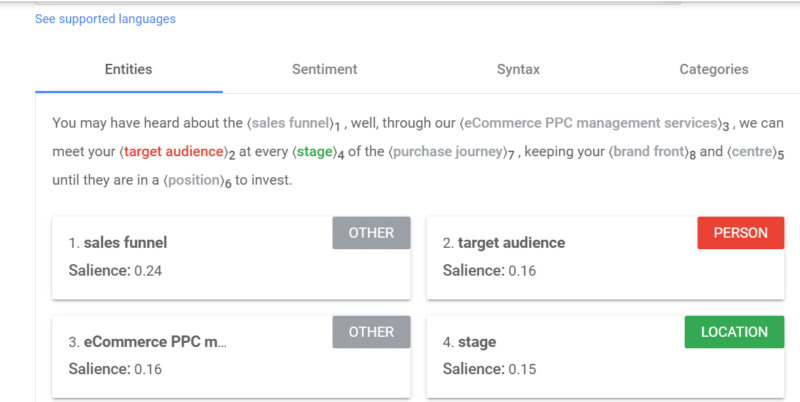
And Google’s NLP tool identifies “sales funnel” and “target audience” as the most salient entities. But this passage is intended to focus on ecommerce PPC management.
I’ll simplify it to get a readability score of 7 (Good) and run the updated version through Google’s NLP tool:
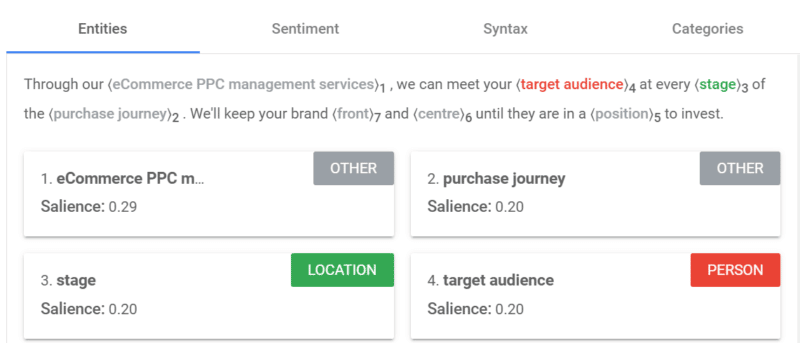
Not only is this easier to follow, but it’s also more relevant to the topic intended.
2. Keep language simple, precise and concise
Following on from readability, it’s best to keep your language as accurate and succinct as possible.
Remove any unnecessary or complex words.
Do your best to write things in their simplest form while maintaining pace and rhythm to keep things interesting.
This will help readers to follow your content and help search engines to process it.
3. Use synonyms and close variants
Repeating the same terms or phrases isn’t a good idea. It creates content that’s laborious to read, and it can appear untrustworthy to a discerning audience.
Optimize your content by upgrading recurrent words to their equivalent alternatives. This will make a much more interesting and engaging reading experience.
It will also provide search engines with more contextual information and avoid the temptation to overuse certain keywords that could result in poor search performance.
The use of synonyms solidifies the topics you’re writing about by providing lots of different points of reference. It can give you wider ranking opportunities, too.
For example, Search Engine Land’s guide “What is PPC?” ranks for a whole host of different synonyms and close variants of PPC, like paid search, search engine marketing, paid search marketing, paid search advertising, pay-per-click search, and more.
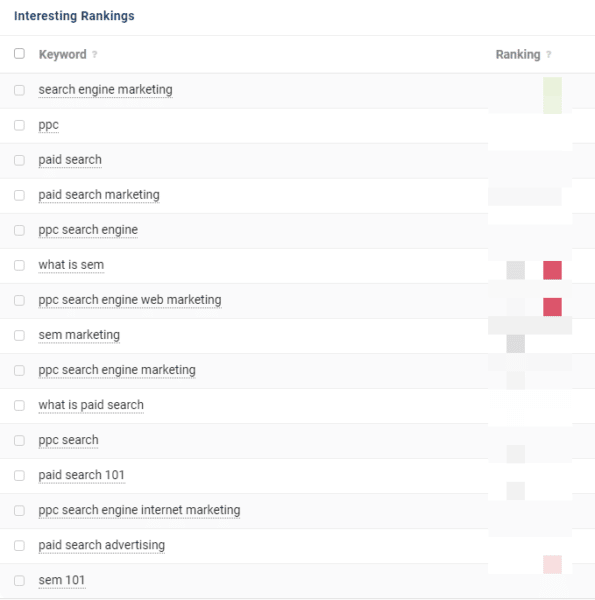
4. Research and include related entities
Every piece of content is a collection of entities, and both search engines and people understand the relationships between many entities.
People have learned over time, for example, that Buckingham Palace is a royal residence located in London, England:
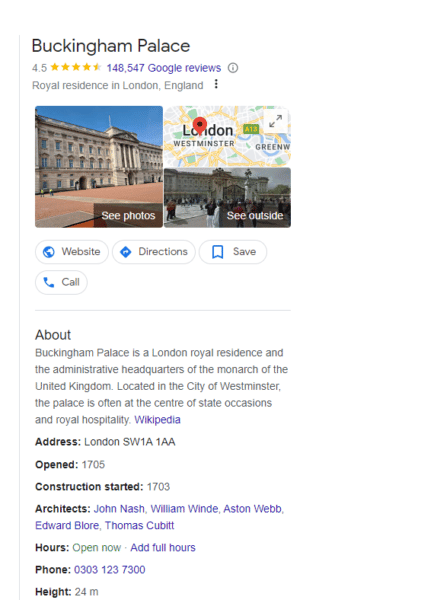
So it is connected to entities like London (location), the late Queen Elizabeth II (person), and certain events, to name just a few.
While some entity relationships like these are well-defined and apparent, others are more subtle. This is why it’s important to research entity associations and consider the connections you’re making within your content.
Making the right associations helps build the bigger picture and give context to your topic. This is useful for your readers and search engines. If you wrote about Buckingham Palace but failed to mention the Royal Family, your content would be lacking.
But entity relationships help to clarify meaning, too. If you’re writing content about the historical figure Anne Hathaway, related entities like William Shakespeare and Stratford Upon Avon provide context. A piece of content about Anne Hathaway, the modern-day movie star, would likely connect entities like films, acting, Academy Awards and New York City.
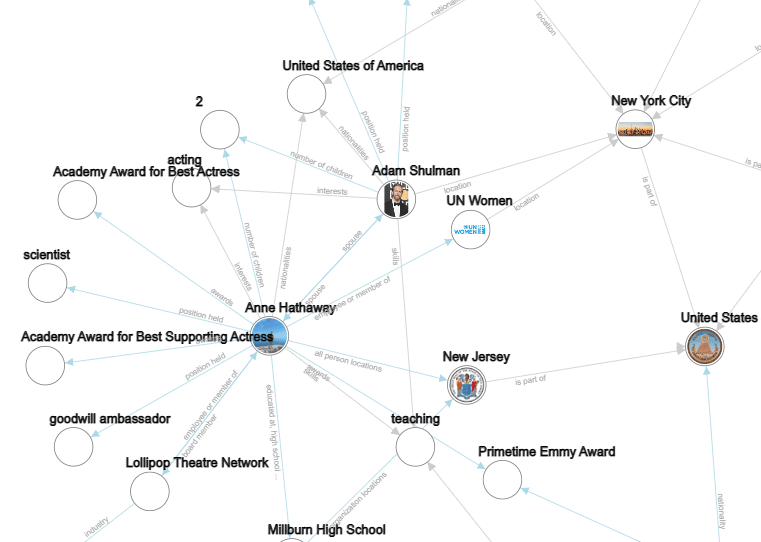
So, when you include an array of relevant entities within your content, it improves the overall piece. It helps to give search engines wider reference points to improve their confidence in what you’re talking about, and it shows your readers that you have thoroughly researched a topic and provided them with a valuable resource.
5. Structure your content
Make sure your content follows a logical, ordered structure. This makes it easier for readers to digest and for search engines to interpret.
For example, this Ideal Home article about how to load a dishwasher is structured simply and effectively. It covers general tips on getting the best results, followed by considering the top and bottom racks.

Other, competing articles cover a muddle of tips. While useful, their structure isn’t as logical and easy to follow.
6. Use headings
An effective heading structure is vital for people and search engines alike.
Clear, descriptive headings help busy readers scan your text more quickly or jump to the areas they’re interested in.
Correctly structured headings are also essential in accessibility. They are used by assistive technology, so good headings allow users of screen readers to navigate effectively and understand your content as intended.
Just like people, search engines love headings, too.
Clear H1, H2 and lower level headings help search engines to understand what your page is about, what each paragraph covers, which topics are important and how they relate to each other.
Mordy Oberstein recently reported some really interesting findings about how improving ambiguous headings actually helped more of his content to get indexed.
This really demonstrates how important clear, informative headings are to content success.
7. Use formatting correctly
The way you format content helps to convey the meaning behind it.
For example, a numbered list might be a step-by-step process or a ranking system. Bullet points usually indicate a list of items with equal importance. Bold or italic text helps items stand out and gives them emphasis.
You’re reading this article now, and I promised you 25 tips. So I labeled these 1-25 to reinforce the message in the title.
The right formatting will help people to read your content in the way you have intended. It will also make it easier to scan and process. But it helps search engines too, as they also recognize these formats and their common meanings.
For example, some formatting will suggest a classification like an address. Other items like tables imply certain relationships. Charts can show averages and ranges.
If I’m interested in the weather in London throughout the year (perhaps I’m planning a trip there) charts and tables convey this information more effectively than text:
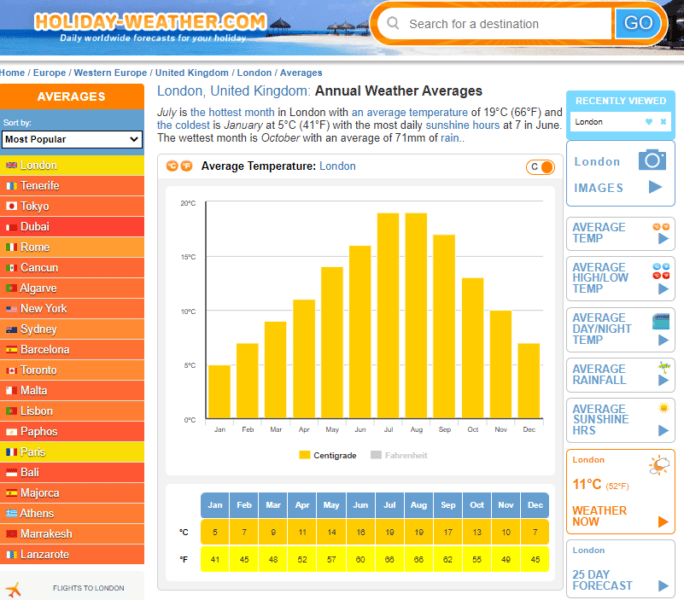
So the formatting here helps to support the message. It creates a better resource for people and search engines by configuring elements most effectively.
Get the daily newsletter search marketers rely on.
See terms.
8. Use a contents section and jump links
If you're producing long-form content, adding a contents section with jump links to each main section can be a helpful optimization.
This will help readers move between sections easily, accessing the information they need. It improves user experience and makes your content more digestible.
From an SEO perspective, these unique internal links help clarify the focus of certain passages, which can boost the passage-based ranking of long-form articles.
In the 2020 article How AI is powering a more helpful Google, Prabhakar Raghavan explained:
"Very specific searches can be the hardest to get right, since sometimes the single sentence that answers your question might be buried deep in a web page. We've recently made a breakthrough in ranking and are now able to better understand the relevancy of specific passages. By understanding passages in addition to the relevancy of the overall page, we can find that needle-in-a-haystack information you're looking for."
So search engines are able to identify useful passages and match them with queries, but it certainly doesn't hurt to point them in the right direction with a clear contents section.
9. Choose usefulness over word count
When you're writing or optimizing content, aim to cover what is useful to your users rather than hitting a word count.
Most people can see right through content that's written to hit a word count. And search engines can, too. The content becomes empty and lacks meaning.
Google's helpful content guidelines ask:
"Are you writing to a particular word count because you've heard or read that Google has a preferred word count? (No, we don't)."
So clearly, they have their eye on this, too.
If you focus on providing enough depth to satisfy your target audience, they will genuinely find it useful. You'll avoid empty words and information that's there just for the sake of it.
10. Do your search term research
Great content should always be based on research. Often, we think we know what our target audience wants, but as content producers, we might have a skewed perspective.
This is where search query data comes in. It's a treasure trove of information about what people are actually looking for. While it's important to use this carefully, it shouldn't be disregarded.
Awareness of how people search for the topics we're writing about is essential for content optimization. Readers will find that your content is more aligned with what they searched for to discover your content, and search engines will serve your content in the right context.
Here's an example of a piece of content in a very specialist niche that was optimized based on search data and republished on a new URL:
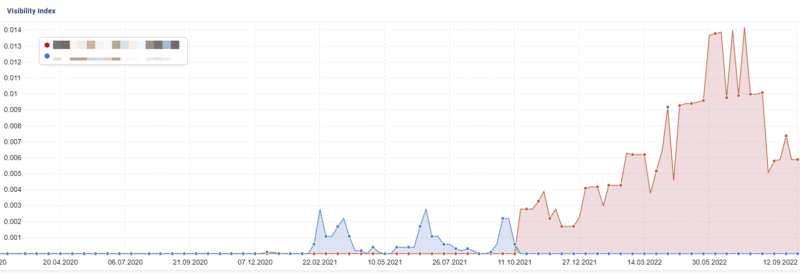
Visibility has increased considerably, and Google Analytics shows a lower exit rate and bounce rate for the new page in comparison to the previous version. This optimized content is clearly more effective for discovery via search and readers alike.
11. Identify an appropriate scope
Consider where your content starts and ends. Should it be combined with other resources to make a better and more useful asset? Or should it be broken down into bitesize chunks?
When you're optimizing content, it's better for both people and search engines if you consider the scope. Something very short might be considered thin content from a search perspective and lacking in detail for your readers.
On the flip side, an extremely long resource might be easier to digest in parts or sections that interlink. Breaking it down could create a series of more focused pieces of content that perform better in search because they're more defined.
For example, Search Engine Land's guide to SEO covers high-level information and includes links to more in-depth chapters about sub-topics. Trying to cover everything about what SEO is in one resource would be too broad a scope.
12. Give direct answers to questions
If you ask a question in your content, provide a direct answer. Don't equivocate or waffle.
Use the expected units or classifications in your answer. Think about the answer you'd like to see!
For example, this passage directly answers a question simply and effectively:
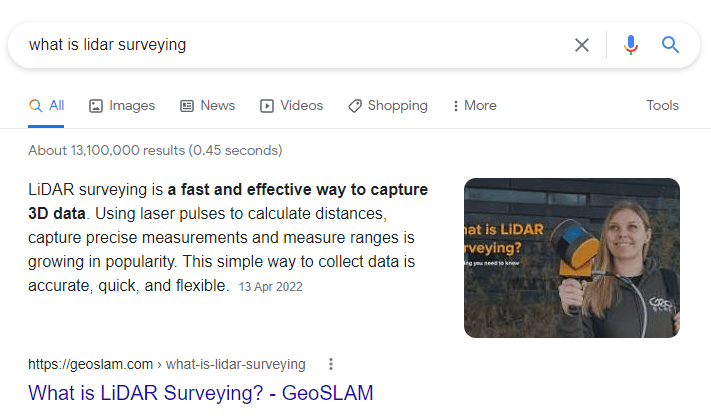
(Disclosure: GeoSLAM is a current client of mine.)
And this one gives a straightforward answer using the expected temperature measures of Celsius and Fahrenheit:

Most people are using search engines to find fast answers to their questions. They don't want to read a debate. They want to access something definitive and unambiguous.
13. Use images to improve understanding
People are visual learners by nature, so consider updating or increasing your images to optimize your content.
Great visuals improve your search performance too. They can boost click-through rate, appear in image search and increase your real estate in SERPs.
The key is to make sure your imagery is really adding value to your content.
- Does it help to illustrate something difficult to understand?
- Does it make a key point more memorable or emotive?
If so, it's likely to be enriching your message.
For example, this technical piece about LiDAR technology aids understanding with simple diagrams:
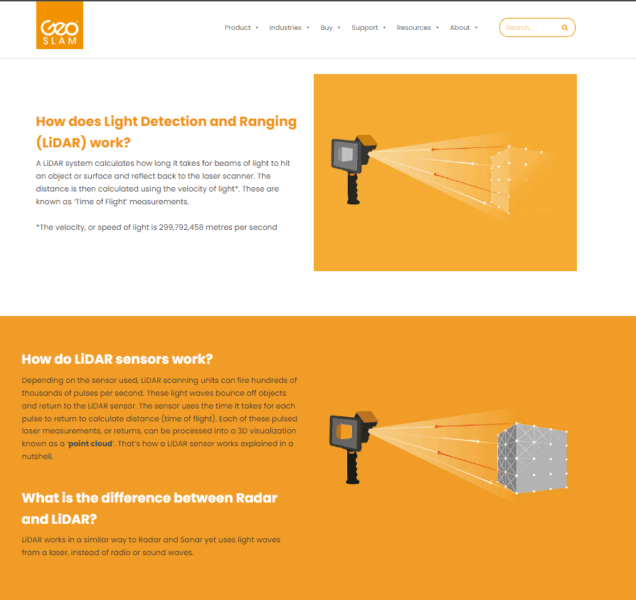
14. Add videos to improve the experience
In 2020, over 3 billion internet users were consuming online video content. This is expected to reach 3.5 billion by next year based on Statista's figures. So, where videos are suitable for supporting or enhancing your content, they're well worth considering as part of your optimization plan.
Many people prefer watching rather than reading, so video content improves their overall experience.
You'll only get real search benefits if you produce original video content yourself. If your budget doesn't stretch this far, embedding useful video content from other producers is still an option.
Overall, creating a better content resource is the aim, which could result in secondary benefits like more shares and backlinks.
15. Assess internal links
When you're optimizing content, make sure you consider internal links.
Does your content link to other useful internal resources? And do other internal pages link to it?
Improving internal linking enhances the experience for readers as it allows them to find out more about a topic of interest. It's also critical for search engines, helping with content discovery, importance and topical relationships.
Earlier this year, Google's John Mueller explained:
- "It's something where internal linking is super critical for SEO. I think it's one of the biggest things that you can do on a website to kind of guide Google and guide visitors to the pages that you think are important. And what you think is important is totally up to you. You can decide to make things important where you earn the most money or you can make things important where you're the strongest competitor or maybe you're the weakest competitor. With internal linking you can really kind of focus things on those directions and those parts of your site."
16. Update external links
Adding external links to your content is a great way to enrich and optimize.
It might seem counterintuitive at first. Why should you send your readers to another website?
But there are multiple benefits if you consider this approach thoughtfully.
People will find your content more trustworthy and useful if you back up claims, statistics or quotes with an authoritative external source. They also add value by giving your audience a fast route to access further information.
But these need regular checking to make sure you're still sending your readers to the most relevant source.
Clear, relevant sourcing also demonstrates expertise in your field, something that search engines value. They provide context that helps solidify the relationship between your content on a certain topic and other expert or authority sites that also cover it.
17. Give examples
A great tip for enhancing your content is to provide real examples. Are there areas that could be explained better by showing how something works rather than trying to explain it in words?
You'll notice I've provided lots of examples throughout this article to help you to follow my thinking. They reinforce my points by showing you a representation of the advice in action, making it easier to apply to your own content.
Showing a representation of your idea in action adds credibility, and makes it more useful and engaging.
18. Ask the experts
If you've produced thought pieces or content that answer a qualitative question, you might be able to upgrade it by asking some experts in the field.
Combining expert quotes that are clearly referenced will enhance E-A-T signals for search engines by demonstrating that you have qualified subject matter experts involved. Readers will get the benefit of a more balanced argument, as well as the recognition of industry expertise.
You might even benefit from attracting eternal backlinks or social activity from the experts involved.
This post on Google penalties from Ahrefs is a great example of reaching out to qualified experts to add value:
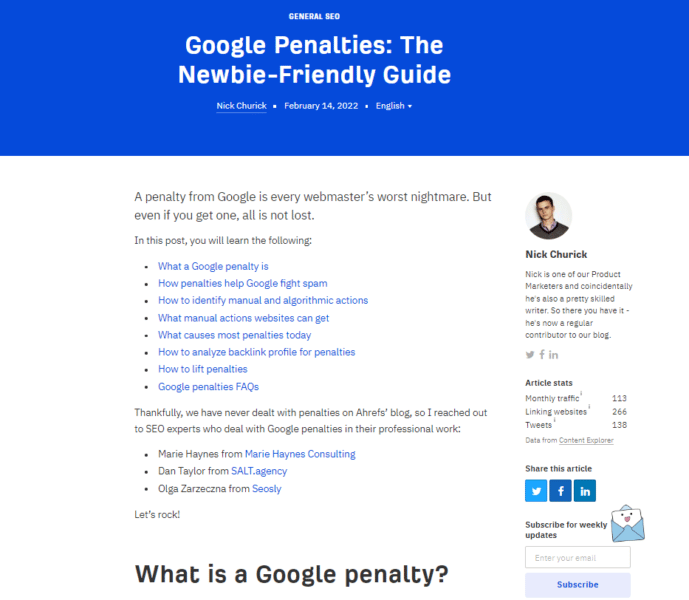
It's gained backlinks from 212 linking domains and just look at the recent uptick in visibility after September's core update (marker H).
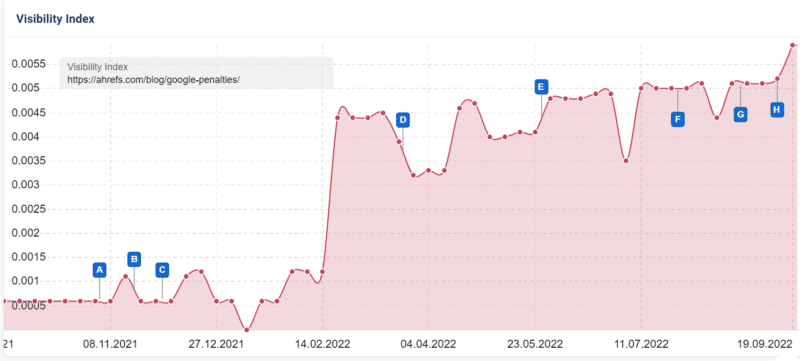
19. Find a new angle
Add value to your content by making sure you approach a given topic differently. If you're just rewriting something that has been covered many times before, you're unlikely to deliver anything insightful or meaningful.
Google's helpful content guidelines state that you should avoid "mainly summarizing what others have to say without adding much value."
So if you have some older content to optimize, perhaps you could approach it from a different perspective or gain some additional insight into the topic.
You might do original research, test something out or ask an expert in the field for additional commentary as mentioned above.
20. Include data
When reviewing your content, consider whether you have made claims that could be backed up with data. Providing hard facts builds trust and shows readers that you have really researched your topic.
From a search perspective, adding relevant data might also provide external linking opportunities. You can reference useful data published on authority sites in your niche.
If you are including your own unique data, there's a strong chance that others writing on a topic will link to your resource to back up their own claims in the future.
For example, this study that benchmarks over 2,000 digital PR pieces gained several relevant backlinks from industry websites in a short time due to the unique, useful and interesting data provided.
21. Keep it up to date
Content optimization never ends, and it's essential to keep your assets current. By carrying out a regular review, you can avoid people accessing outdated content that could provide obsolete advice.
Search engines use freshness as a ranking factor, so they value content that's well maintained and kept up to date. Studies by Botify have confirmed this, although it's a complex issue.
One ecommerce site I worked on was experiencing a downturn in traffic for a key page, and through analysis, I noticed that "prices start from" was mentioned in the copy, but the minimum price had changed. After correcting the price, performance returned to its previous levels.
22. Keep it relevant
Make sure the topic of your content is highly relevant to your area of expertise.
People reading content that's detached from your main topic area may find this confusing, unhelpful or might fail to trust it.
Search engines are working toward a better user experience, so they mirror this. I've carried out many content audits over recent months on different types of websites.
Assessing a site's content as a whole usually reveals a lot, but one of the predominant findings has usually been that relevant content performs much better than unrelated content.
There are several reasons for this. In most cases, the content is likely to be better quality if subject matter experts create it. But the relationships between pages matter, too.
Content clustering displays a breadth of knowledge about a topic that interlinks, which can help you build up topical authority over time. I covered this in more detail in my recent article on how to use relationships in SEO.
23. Take your time
Considering the implications of content optimization on search and users alike takes time.
The time taken to write a blog post is just over 4 hours on average, and that has increased by 67% since 2014, a large-scale study by Orbit Media shows.
This just goes to show that the quality, level of detail and expertise involved are only increasing. Older content may require extra time to optimize and bring up to current standards.
If you want to do a thorough job, allow yourself the time you need to develop your content and strengthen it.
24. Analyze the results
If you're optimizing content, use results to guide you. Data will provide valuable information about what's working in search and how people engage with your content. You should analyze both.
This page, which was improved using data from Google Search Console and Google Analytics, has performed much better after optimization. Total impressions have increased by 359%, and clicks have increased by 433%.

Google Analytics shows that the average time on page has increased, indicating that the content refresh is not only bringing in more traffic but is engaging readers.
25. Check and check again
Spell check, grammar check and fact check.
Maybe you missed something the first time and have published content with inaccuracies. Any errors will erode trust with your readers. They could also hamper your search performance.
I find it really valuable to have a proofing process in place within my team. It's much easier to spot someone else's errors and review content from a pragmatic perspective if you haven't written it yourself.
Balance humanity and SEO
It's never been more important to get the right balance between enhancing content for search engines and people.
An ideal mix is a user-first approach with a good grounding in SEO.
Neither should be ignored when you're optimizing content.
Search engines are crucial for driving an audience to your content, but you don't want your readers to be disappointed when they get there.
Keep both in mind, and search engines and your readers can work hand in hand to deliver exceptional results.
Opinions expressed in this article are those of the guest author and not necessarily Search Engine Land. Staff authors are listed here.
Related Stories
New on Search Engine Land
25 tips to optimize your content for people and search engines
The latest jobs in search marketing
GA4 now has an enhanced measurement option for Form interactions
5 massive SEO and content shifts you need to master right now
The 2023 Digital Marketing Salary Guide is here







